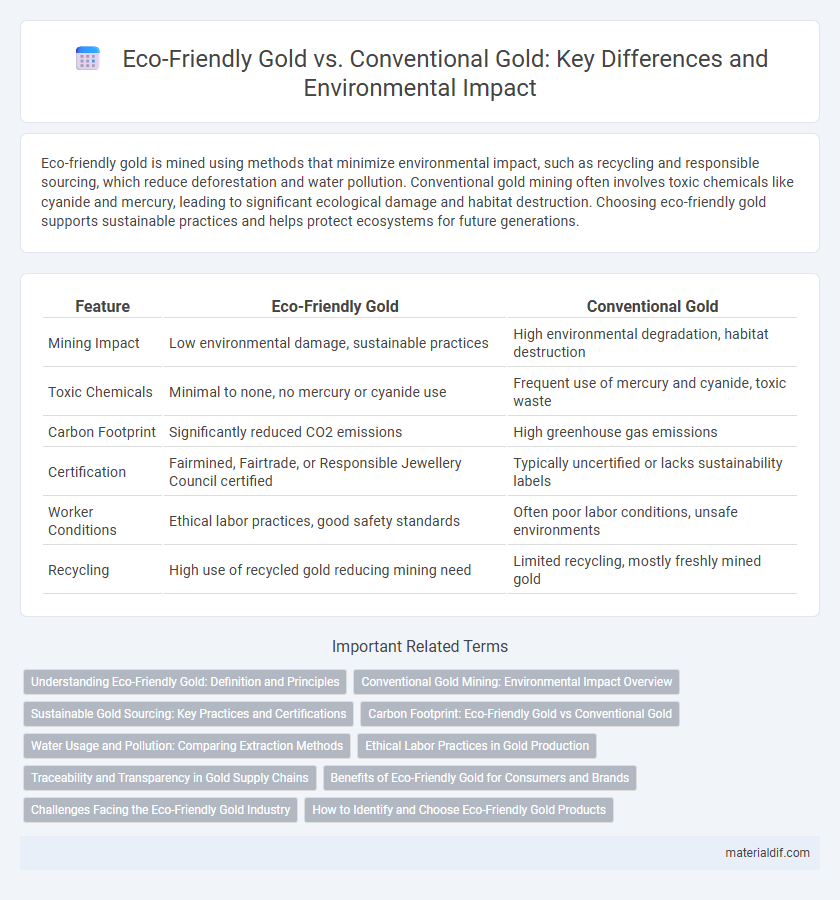Eco-friendly gold is mined using methods that minimize environmental impact, such as recycling and responsible sourcing, which reduce deforestation and water pollution. Conventional gold mining often involves toxic chemicals like cyanide and mercury, leading to significant ecological damage and habitat destruction. Choosing eco-friendly gold supports sustainable practices and helps protect ecosystems for future generations.
Table of Comparison
| Feature | Eco-Friendly Gold | Conventional Gold |
|---|---|---|
| Mining Impact | Low environmental damage, sustainable practices | High environmental degradation, habitat destruction |
| Toxic Chemicals | Minimal to none, no mercury or cyanide use | Frequent use of mercury and cyanide, toxic waste |
| Carbon Footprint | Significantly reduced CO2 emissions | High greenhouse gas emissions |
| Certification | Fairmined, Fairtrade, or Responsible Jewellery Council certified | Typically uncertified or lacks sustainability labels |
| Worker Conditions | Ethical labor practices, good safety standards | Often poor labor conditions, unsafe environments |
| Recycling | High use of recycled gold reducing mining need | Limited recycling, mostly freshly mined gold |
Understanding Eco-Friendly Gold: Definition and Principles
Eco-friendly gold refers to gold that is mined, processed, and refined with minimal environmental impact, adhering to sustainable practices such as reducing water usage, avoiding toxic chemicals like mercury and cyanide, and maintaining biodiversity. This type of gold certification often involves strict adherence to guidelines set by organizations such as the Responsible Jewellery Council (RJC) and Fairmined, ensuring transparency and ethical sourcing. Sustainable gold mining principles emphasize social responsibility, environmental stewardship, and economic development within mining communities to mitigate the adverse effects of conventional gold production.
Conventional Gold Mining: Environmental Impact Overview
Conventional gold mining significantly disrupts ecosystems through deforestation, soil erosion, and water contamination from toxic chemicals like cyanide and mercury. Large-scale extraction processes generate substantial greenhouse gas emissions and create vast amounts of tailings that pollute nearby rivers and groundwater. These environmental impacts contribute to biodiversity loss and pose long-term risks to human health and local communities.
Sustainable Gold Sourcing: Key Practices and Certifications
Sustainable gold sourcing prioritizes eco-friendly practices such as responsible mining, minimal environmental impact, and ethical labor standards, ensuring the protection of ecosystems and local communities. Key certifications like Fairtrade Gold, Responsible Jewellery Council (RJC), and Alliance for Responsible Mining (ARM) verify compliance with stringent environmental and social criteria. These certifications promote transparency, traceability, and accountability throughout the gold supply chain, distinguishing eco-friendly gold from conventional gold mining operations.
Carbon Footprint: Eco-Friendly Gold vs Conventional Gold
Eco-friendly gold significantly reduces carbon footprint by utilizing sustainable mining practices, renewable energy, and recycling methods that lower greenhouse gas emissions compared to conventional gold mining. Conventional gold extraction often involves energy-intensive processes, heavy use of fossil fuels, and deforestation, leading to higher carbon dioxide emissions and environmental degradation. Transitioning to eco-friendly gold supports carbon neutrality goals and promotes responsible consumption in the jewelry and investment industries.
Water Usage and Pollution: Comparing Extraction Methods
Eco-friendly gold mining significantly reduces water usage by implementing advanced recycling systems that limit freshwater withdrawal to less than 50% compared to conventional methods. Traditional gold extraction often relies on cyanide and mercury, causing severe water pollution and long-term ecosystem damage through toxic runoff. Sustainable practices prioritize closed-loop water treatment, effectively minimizing contamination and preserving aquatic biodiversity.
Ethical Labor Practices in Gold Production
Eco-friendly gold production emphasizes ethical labor practices by ensuring fair wages, safe working conditions, and the prohibition of child labor, contrasting sharply with conventional gold mining, where labor exploitation and unsafe environments are prevalent. Certified eco-friendly gold sources often comply with international labor standards and third-party audits, promoting transparency and accountability. Consumers seeking ethically produced gold can rely on certifications such as Fairtrade Gold and the Responsible Jewellery Council to verify ethical labor compliance.
Traceability and Transparency in Gold Supply Chains
Eco-friendly gold production prioritizes traceability and transparency by utilizing blockchain technology and independent certification to track gold from mine to market, ensuring ethical sourcing and minimizing environmental impact. Conventional gold supply chains often lack clear documentation and accountability, leading to risks of conflict mining and environmental degradation. Enhanced transparency in eco-friendly gold enables consumers and investors to verify sustainable practices and ethical labor standards throughout the entire supply chain.
Benefits of Eco-Friendly Gold for Consumers and Brands
Eco-friendly gold offers consumers a sustainable choice by minimizing environmental impact through responsible sourcing and reduced chemical use, ensuring cleaner production processes. Brands benefit from enhanced reputation and consumer trust by aligning with ethical standards and meeting increasing demand for transparent, socially responsible products. This approach also supports biodiversity conservation and fair labor practices, adding value to the gold supply chain while promoting long-term ecological balance.
Challenges Facing the Eco-Friendly Gold Industry
Eco-friendly gold production faces significant challenges including higher costs associated with sustainable mining practices and strict regulatory compliance that limits operational scalability. Limited consumer awareness and demand for responsibly sourced gold also hinder market growth, while the industry struggles with technical difficulties in purifying gold without harmful chemicals. Supply chain transparency remains a critical issue, complicating certification processes and increasing the risk of fraud in eco-friendly gold labeling.
How to Identify and Choose Eco-Friendly Gold Products
Eco-friendly gold is sourced through sustainable mining practices that minimize environmental impact and ensure fair labor conditions, distinguishable by certifications such as Fairmined or Responsible Jewellery Council (RJC) approval. Consumers should look for products labeled with these certifications and verify supply chain transparency using blockchain tracking or vendor sustainability reports. Choosing eco-friendly gold supports reduced ecological damage and promotes ethical standards, making it a responsible alternative to conventional gold mined with harmful chemicals and exploitative labor.
Eco-Friendly Gold vs Conventional Gold Infographic

 materialdif.com
materialdif.com